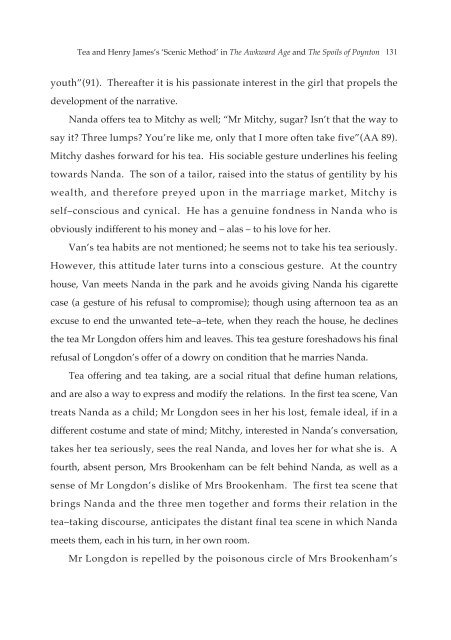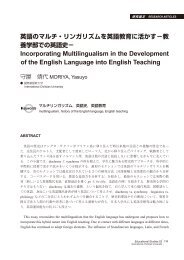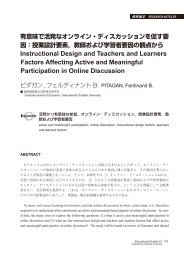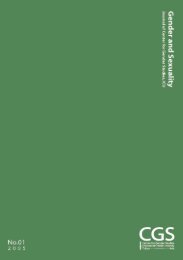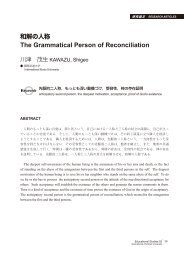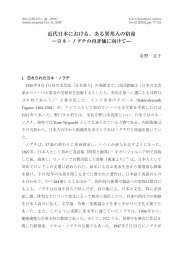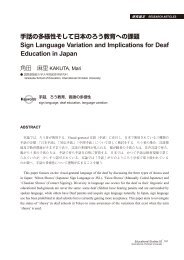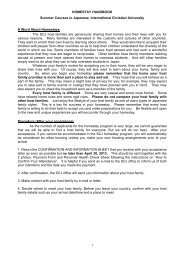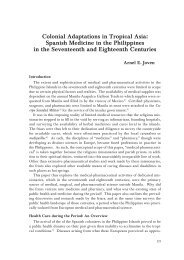Tea and Henry James's 'Scenic Method' in The Awkward ... - subsite
Tea and Henry James's 'Scenic Method' in The Awkward ... - subsite
Tea and Henry James's 'Scenic Method' in The Awkward ... - subsite
Create successful ePaper yourself
Turn your PDF publications into a flip-book with our unique Google optimized e-Paper software.
<strong>Tea</strong> <strong>and</strong> <strong>Henry</strong> James’s ‘Scenic Method’ <strong>in</strong> <strong>The</strong> <strong>Awkward</strong> Age <strong>and</strong> <strong>The</strong> Spoils of Poynton<br />
131<br />
youth”(91). <strong>The</strong>reafter it is his passionate <strong>in</strong>terest <strong>in</strong> the girl that propels the<br />
development of the narrative.<br />
N<strong>and</strong>a offers tea to Mitchy as well; “Mr Mitchy, sugar? Isn’t that the way to<br />
say it? Three lumps? You’re like me, only that I more often take five”(AA 89).<br />
Mitchy dashes forward for his tea. His sociable gesture underl<strong>in</strong>es his feel<strong>in</strong>g<br />
towards N<strong>and</strong>a. <strong>The</strong> son of a tailor, raised <strong>in</strong>to the status of gentility by his<br />
wealth, <strong>and</strong> therefore preyed upon <strong>in</strong> the marriage market, Mitchy is<br />
self–conscious <strong>and</strong> cynical. He has a genu<strong>in</strong>e fondness <strong>in</strong> N<strong>and</strong>a who is<br />
obviously <strong>in</strong>different to his money <strong>and</strong> – alas – to his love for her.<br />
Van’s tea habits are not mentioned; he seems not to take his tea seriously.<br />
However, this attitude later turns <strong>in</strong>to a conscious gesture. At the country<br />
house, Van meets N<strong>and</strong>a <strong>in</strong> the park <strong>and</strong> he avoids giv<strong>in</strong>g N<strong>and</strong>a his cigarette<br />
case (a gesture of his refusal to compromise); though us<strong>in</strong>g afternoon tea as an<br />
excuse to end the unwanted tete–a–tete, when they reach the house, he decl<strong>in</strong>es<br />
the tea Mr Longdon offers him <strong>and</strong> leaves. This tea gesture foreshadows his f<strong>in</strong>al<br />
refusal of Longdon’s offer of a dowry on condition that he marries N<strong>and</strong>a.<br />
<strong>Tea</strong> offer<strong>in</strong>g <strong>and</strong> tea tak<strong>in</strong>g, are a social ritual that def<strong>in</strong>e human relations,<br />
<strong>and</strong> are also a way to express <strong>and</strong> modify the relations. In the first tea scene, Van<br />
treats N<strong>and</strong>a as a child; Mr Longdon sees <strong>in</strong> her his lost, female ideal, if <strong>in</strong> a<br />
different costume <strong>and</strong> state of m<strong>in</strong>d; Mitchy, <strong>in</strong>terested <strong>in</strong> N<strong>and</strong>a’s conversation,<br />
takes her tea seriously, sees the real N<strong>and</strong>a, <strong>and</strong> loves her for what she is. A<br />
fourth, absent person, Mrs Brookenham can be felt beh<strong>in</strong>d N<strong>and</strong>a, as well as a<br />
sense of Mr Longdon’s dislike of Mrs Brookenham. <strong>The</strong> first tea scene that<br />
br<strong>in</strong>gs N<strong>and</strong>a <strong>and</strong> the three men together <strong>and</strong> forms their relation <strong>in</strong> the<br />
tea–tak<strong>in</strong>g discourse, anticipates the distant f<strong>in</strong>al tea scene <strong>in</strong> which N<strong>and</strong>a<br />
meets them, each <strong>in</strong> his turn, <strong>in</strong> her own room.<br />
Mr Longdon is repelled by the poisonous circle of Mrs Brookenham’s


